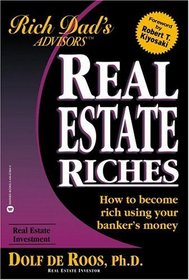Helpful Score: 3
I am a real estate investor myself and have read many books on this subject. The approach de Roos puts forth in this book is a joke. It's overly-simplified and much more of just trading on the Rich Dad brand to sell books than anything else. While I agree that commercial properties are some of the best investment vehicles out there, I do not believe that you can just buy them all up and use their cashflow to finance other properties very easily. The truth is many full-time investors only do a few deals a year at most, yet de Roos makes it sound like there are 5 great properties out there at any given moment. Look elsewhere if you want to become a serious investor.
Bruce T. reviewed Real Estate Riches: How to Become Rich Using Your Banker's Money on + 5 more book reviews
Helpful Score: 2
Roos is part real estate investor, part cheerleader. If real estate investing were as simple as getting excited about real estate investing then we'd read this book, leave our 9-5s, and, ahhh, riches. Real Estate Riches inspires me to invest in real estate the way Bruce Lee inspired me as a kid to become a kung fu master. It's great to dream about, but the hard work between the dream and the reality is usually enough dissuade.
His basic plan-of-action is 1) use as little of your money as possible and as much of the bank's money, to, 2) --he skips this part about how hard it is it find and identify a positive cash flow property, then, 3) buy a place that continues to increase in value, while it simultaneously delivers cash in your pocket each month, and finally, 4) when you need more money to invest, drain the equity from your property and repeat.
I think the best advice he gives, and the one insight you might find to be part of the real work of real estate investing, is the 100:10:3:1 rule. Look at _100_ properties, make offers on 10, negotiate financing on 3, and you MAY buy 1. Real estate investing is hard work. Roos show you all of the glamour, but little of the daily grind that's involved to make it happen for yourself.
For a more balanced approach see Real Estate Investing, 4th edition by McLean and Eldred.
His basic plan-of-action is 1) use as little of your money as possible and as much of the bank's money, to, 2) --he skips this part about how hard it is it find and identify a positive cash flow property, then, 3) buy a place that continues to increase in value, while it simultaneously delivers cash in your pocket each month, and finally, 4) when you need more money to invest, drain the equity from your property and repeat.
I think the best advice he gives, and the one insight you might find to be part of the real work of real estate investing, is the 100:10:3:1 rule. Look at _100_ properties, make offers on 10, negotiate financing on 3, and you MAY buy 1. Real estate investing is hard work. Roos show you all of the glamour, but little of the daily grind that's involved to make it happen for yourself.
For a more balanced approach see Real Estate Investing, 4th edition by McLean and Eldred.





